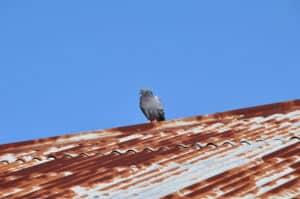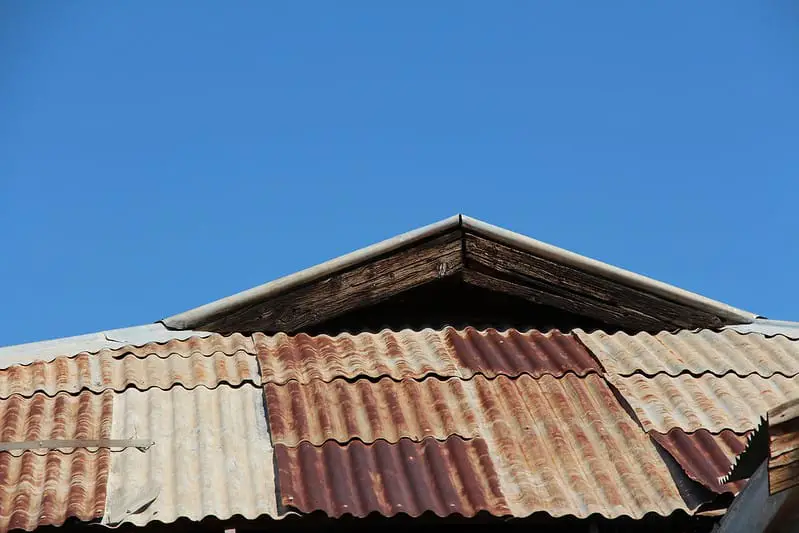Owning a manufactured home is something perpetually appealing.
However, most manufactured home roofs are made of metal, making them susceptible to rust and corrosion.
Like any other type of roofing, a manufactured home’s needs to be checked at intervals, repaired, and maintained.
Getting rust off your manufactured home roof is one of the best ways to maintain it and benefit most before investing in a replacement.
So, How Do You Get The Rust Off A Manufactured Home Roof?
While frequent cleaning protects your roof against rust, it doesn’t guarantee that your roof will endlessly stay rust-free.
To remove rust from your manufactured home roof, scrub it with a solution of one part chlorine and three parts water.
For notorious rusty patches, you may need to sand them.
Allow your roof to dry completely before coating to prevent future rusting.
Having a rusty roof can be threatening.
However, it can be removed and treated in a few simple ways if caught in time.
This guide will introduce to you everything you need to know about manufactured home roof rusting and how to solve this formidable issue.
Let’s get started.
Related: Should You Get A Roof Over Kit?
What Causes Rust On Manufactured Home Roofs?

Rust on roofs is a common problem on metal roofs and metal roof fixtures.
The primary cause of corrosion on roofs is moisture and dirt accumulating on its surface with time. This is why proper maintenance, including clearing leaves, moss, and soil regularly, is encouraged to ensure its long life.
Basically, manufactured home metal roofs are designed not to be waterproof but for water flow because water (moisture) is the leading cause of rust.
Oxygen in water bonds with iron atoms in your roof; therefore, causing oxidation.
The result of oxidation is rust, which is scientifically known as iron oxide (III).
Consequently, it is a no-brainer to say that rust in manufactured home roofs results from the metal roof reacting with the environment.
Here Is How To Deal With Roof Rust
Nothing ruins your home’s curb appeal like a stained roof. If you have rust developing on your manufactured home roof, then it is time to do something about it.
Although rust is a common issue in older homes, any uncoated metal roofing is susceptible to corrosion.
Typically, the longer your roof is exposed to moisture, the more it gets prone to rust.
The easiness of getting rust off your roof depends on what time you noticed the problem.
1. Method #1: Sandpaper, Wire Brush


The most common method of removing rust is attacking the patches with a wire brush or sandpaper.
You will need to use the right ingredients to achieve better results with minimal effort.
Scrubbing the metal roof with a solution of one part chlorine and three parts of water is highly recommended because it effectively removes rust and mildew.
White vinegar or a mix of lemon juice and water should also absorb patches and scrub the surface clean.
2. Method #2: Oxalic Acid
Another highly effective method of cleaning rust from your manufactured home roof is using a fairly concentrated solution of oxalic acid.
Unlike other scrubbing solutions, oxalic acid is just sprayed using a spray bottle or pressure washing machine.
After scrubbing or spraying the rust patches with the ideal solution, wash the roof with a mild detergent mixed with water.
Rinse your manufactured home roof thoroughly.
You will need to waterproof your roof appropriately to prevent future rusting.
How To Remove Rust Stains From Asphalt Shingles In Three Steps


Although rusting is common on metal roofs, asphalt shingle roofs can also get affected.
But, the rust stains are usually not from the roofing materials.
Rust stains on manufactured home shingle roofs are caused by in the vicinity metal fixtures like flashing.
Rust from these nearby metals bleeds onto shingles, discoloring your roof.
Cleaning rust patches on asphalt shingles is quite easy but needs some commitment. When cleaning rusty patches on shingle roofs, keep in mind that the roof is susceptible to breakage.
Follow these steps to remove rust stains on manufactured home asphalt shingle roofs.
- Clean your roof thoroughly. This helps you to identify the cause of rust stains accurately. Cleaning also removes other debris that might harden the process of removing the stains.
- Treat the rust patches with vinegar or any other useful solution while observing safety measures. Allow the vinegar to stay for about 5 minutes and scrub with a brush. For notorious stains, use oxalic acid to effectively clear the stains.
- Rinse your roof with plenty of water to remove any residue. When rinsing, you may want to use a push broom for thorough cleansing. The stains should have disappeared.
Related: How Do You Quieten a Noisy Manufactured Home Roof?
Waterproofing The Manufactured Home Roof In Five Steps
Roof coating is a must-do thing if you want to protect the beauty of your manufactured home roof.
It also renews considerably older roofs; therefore, extending their life and improving functionality as well.
Weathertight roof coating prevents your roof from getting exposed to elements, including moisture, which causes rust.
Besides protecting your roof, coating optimizes energy efficiency.
However, before applying the coat, you will need to measure your roof accurately to buy enough paint. You will also need to apply two layers.
1. Surface preparation
The first thing when applying roof coating is to perform a thorough cleaning of the surface.
Although you might have washed your roof after removing the rust patches, you may need to pressure wash it to remove any left surface contaminants.
Cleaning maximizes adhesion and coverage when coating.
2. Roof inspection and repair
You will want to verify if everything is in place and secure.
If your manufactured home roof has ponding water issues, you should reinforce the section to create a new slope for water to drain.
After reinforcing, check for any cracks, voids, blisters, loose seams, and other roof surface imperfections, then repair them appropriately.
If spots from which you remove rust are too weak, you can add a sizable sheet and secure it into place with caulk.
3. Clear Away Unnecessary Items
Remove or cover anything that might be vulnerable to overspray, like skylights.
4. Apply roof coating


When the sealant has set and the roof is dry, apply the first coat generously using a professional ½-inch paint roller.
Roof coating is a pretty easy job, especially if you are a savvy DIYer.
However, it requires attention to detail and a few skills. Cut in along edges and coat from one end to another.
Make sure to follow the manufacturer’s instructions.
Allow the initial coat to dry, typically 6-24 hours, depending on the weather. Ideally, roof coating should be done on a clear, warm, sunny day.
5. Recoat the surface to make it more resistant to elements
You may also opt to paint it so that it looks new. Coating and painting will keep rust from forming for considerably longer on top of ensuring long life.
The right coating can save your money, reduce environmental impacts, and add life to your manufactured home roof.
Seven Safety Tips When Working On Manufactured Home Roofs
Before stepping on your manufactured home roof for whatever reason, keep in mind that you’re susceptible to falling. Besides falling, you can potentially damage your roof.
Here are some of the ways to ensure your safety.
- Keep the working area organized and clean by ensuring tools and equipment are blocked from third-party, including children, animals, and pedestrians.
- Read caution labels on chemicals, primer, sealant, and adhesive containers. This will ensure you use the products for what they are designed for and do it appropriately.
- Wear appropriate gear. Modern manufactured homes feature pitched roofs; therefore, you need footwear that offers adequate traction. Besides, most of the chemicals used to remove rust on manufactured home roofs are harmful. For this reason, you will need to stay armed with goggles, gloves, and hardhats.
- Secure ladders with stabilizers or through any other means to keep it steady and avoid damaging the gutter system
- Do work when the weather is inclement or extremely hot.
- Do not step on wet surfaces. Wet roof coatings are slippery, which makes it hazardous. If you must get on a wet roof, add roof granules, and have the right footwear.
- Know where you are stepping next. Regardless of what you are doing, you should be careful and understand where you are, especially when approached edges.
Here Are Five Additional Home Roof Care Tips
- Don’t let branches overgrow and rub against your roof. Running can tamper with the finish making the roof susceptible to rust.
- Don’t allow debris to build up on the roof surface. Debris damages roof finishes and accumulates moisture, which is a leading cause of rust on manufactured home roofs.
- Clean gutters regularly
- Check sealants from time to time. Faulty sealants lead to corrosion.
- Repair any cracks, holes, and other roof surface imperfections that might cause the manufactured home roof to corrode.
Conclusion
Having rusty patches on your manufactured home roof can be annoying.
Although getting rust off your roof seems intimidating, it doesn’t have to be much difficult.
If you are a savvy DIYer, the process is relatively easy, but hiring a professional roofer to do it for you is the best option if you doubt your skills.



